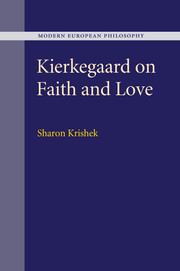Introduction: stages on love's way
Published online by Cambridge University Press: 04 August 2010
Summary
Kierkegaard, love, and romantic love
And yet it must be wonderful to get the princess, and the knight of faith is the only happy man … to live happily with her day after day … this is wonderful.
(FT, 50)… erotic love is undeniably life's most beautiful happiness.
(WL, 267)Romantic love, in contrast with neighbourly love or love for God, is rarely viewed as an important issue for Kierkegaard. Despite the textual evidence regarding the centrality of this kind of love in his works, scholars in this field often seem reluctant to take the matter seriously. When required to address Kierkegaard's repeated references to love stories, the secondary literature tends either to interpret this as a literary device or, more frequently, to relate this to his unhappy personal relationship with Regine Olsen, his forsaken fiancée. This ‘biographical’ approach is common among interpreters of Kierkegaard who believe that a complete understanding of his work requires a thorough understanding of his life, and vice versa. Such an interpretative method was dominant among earlier scholars (P. A. Heiberg and Walter Lowrie, for example), but it still has its ardent followers today (as demonstrated by Gene Fendt's book on Works of Love and especially by the comprehensive biography of Kierkegaard by Joakim Garff). However, intriguing as this approach to interpreting Kierkegaard may be, it is evident that it does not take his preoccupation with romantic love to be philosophically enlightening.
- Type
- Chapter
- Information
- Kierkegaard on Faith and Love , pp. 1 - 16Publisher: Cambridge University PressPrint publication year: 2009

